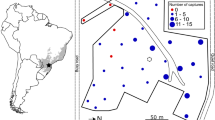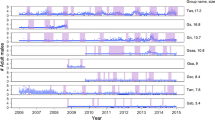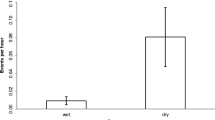Abstract
We examined agonistic interactions between adult females in wild, unprovisioned patas monkeys (Erythrocebus patas) and vervets (Cercopithecus aethiops). The dominance hierarchy of patas is far less clear than that of vervets. Patas had fewer interactions per dyad, fewer dyads with interactions, and a high percentage (18%) of reversals in which lower-ranking females won in agonistic interactions with higher-ranking females. Although the rank ordering of the kinds of interactions patas and vervets displayed is similar, with avoidance being the most frequently observed agonistic response to approaches by other females, patas were chased and supplanted more often than vervets were. The resources over which females were supplanted also differ between species. Supplants over food comprise smaller proportion of total supplants patas than for vervets. Patas appear to feed on less usurpable foods than vervets. We conclude that (1) Erythrocebus and Cercopithecus spp., except C. aethiops, should not be categorized with other Cercopithecinae, and C. aethiops should not be categorized with other Cercopithecus spp. and Erythrocebus, in discussions and analyses of relationships between females within groups and (2) ecological conditions, i.e., usurpability of foods, can override phylogenetic history as the selective pressure determining the nature of female competitive relationships within groups.
Similar content being viewed by others
REFERENCES
Altmann, S. A., and Altmann, J. (1970). Baboon Ecology: African Field Research, University of Chicago Press, Chicago.
Appleby, M. C. (1983). The probability of linearity in hierarchies. Anim. Behav. 31: 600–608.
Barton, R. A., and Whiten, A. (1993). Feeding competition among female olive baboons, Papio anubis. Anim. Behav. 46: 777–789.
Boccia, M. L., Laudenslager, M., and Reite, M. (1988). Food distribution, dominance, and aggressive behaviors in bonnet macaques. Am. J. Primatol. 16: 123–130.
Borries, C. (1993). Ecology of female social relationships: Hanuman langurs (Presbytis entellus) and the van Schaik model. Folia Primatol. 61: 21–30.
Borries, C., Sommer, V., and Srivastava, A. (1991). Dominance, age, and reproductive success in free-ranging Hanuman langurs (Presbytis entellus). Int. J. Primatol. 12: 1–28.
Brennan, J., and Anderson, J. R. (1988). Varying responses to feeding competition in a group of rhesus monkeys (Macaca mulatta). Primates 29: 353–360.
Chapais, B. (1988a). Rank maintenance in female Japanese macaques: experimental evidence for social dependency. Behaviour 104: 41–59.
Chapais, B. (1988b). Experimental matrilineal inheritance of rank in female Japanese macaques. Anim. Behav. 36: 1025–1037.
Chapais, B., Girard, M., and Primi, G. (1991). Non-kin alliances, and the stability of matrilineal dominance relations in Japanese macaques. Anim. Behav. 41: 481–492.
Cheney, D. L., Lee, P. C., and Seyfarth, R. M. (1981). Behavioral correlates of nonrandom mortality among free-ranging adult female vervet monkeys. Behav. Ecol. Socibiol. 9: 153–161.
Cords, M. (1987). Forest guenons and patas monkeys: Male-male competition in one-male groups. In Smuts, B. B., Cheney, D. L., Seyfarth, R. M., Wrangham, R. W., and Struhsaker, T. T. (eds.), Primate Societies, University of Chicago Press, Chicago, pp. 98–111.
Cords, M. (1998). The agonistic and affiliative relationships of adult females in a blue monkey group. In Jolly, C., and Whitehead, P. (eds.), Old World Monkeys, Cambridge University Press, Cambridge (in press).
Deag, J. M. (1977). Aggression and submission in monkey societies. Anim. Behav. 25: 465–474.
de Vries, H. (1995). An improved test of linearity in dominance hierarchies containing unknown or tied relationships. Anim. Behav. 50: 1375–1389.
de Waal, F. B. M. (1989). Dominance “style” and primate social organization. In Standen, V., and Foley, R. A. (eds.), Comparative Socioecology: The Behavioural Ecology of Humans and other Mammals, Blackwell, Oxford, pp. 243–263.
Disotell, T. R. (1996). The phylogeny of Old World monkeys. Evol. Anthropol. 5: 18–24.
Gartlan, J. S. (1968). Structure and function in primate society. Folia Primatol. 8: 89–120.
Goldman, E. N., and Loy, J. (1997). Longitudinal study of dominance relations among captive patas monkeys. Am. J. Primatol. 42: 41–51.
Harcourt, A. H. (1978). Strategies of emigration and transfer by female primates, with particular reference to gorillas. Z. Tierpsychol. 48: 401–420.
Harcourt, A. H. (1979). Social relationships among female mountain gorillas. Anim. Behav. 27: 251–264.
Harcourt, A. H. (1987). Dominance and fertility among female primates. J. Zool. Lond. 213: 471–487.
Harcourt, A. H., and Stewart, K. J. (1987). The influence of help in contests on dominance rank in primates: Hints from gorillas. Anim. Behav. 35: 182–190.
Harvey, P. H., and Pagel, M. D. (1991). The Comparative Method in Evolutionary Biology, Oxford University Press, Oxford.
Hausfater, G. (1975). Dominance and reproduction in baboons (Papio cynocephalus). Contrib. Primatol. Vol. 7, Karger, Basel.
Hausfater, G., Altmann, J., and Altmann, S. (1982). Long-term consistency of dominance relations among female baboons (Papio cynocephalus). Science 217: 752–754.
Hill, D. A., and Okayasu, N. (1996). Determinants of dominance among female macaques: nepotism, demography and danger. In Fa, J. E., and Lindburg, D. G. (eds.), Evolution and Ecology of Macaque Societies, Cambridge University Press, Cambridge, pp. 459–472.
Horrocks, J., and Hunte, W. (1983). Maternal rank and offspring rank in vervet monkeys: An appraisal of the mechanisms of rank acquisition. Anim. Behav. 31: 772–782.
Hrdy, S. B., and Hrdy, D. (1976). Hierarchical relations among female Hanuman langurs (Primates: Colobinae, Presbytis entellus). Science 193: 913–915.
Isbell, L. A. (1983). Daily ranging behavior of red colobus (Colobus badius tephrosceles) in Kibale Forest, Uganda. Folia Primatol. 41: 34–48.
Isbell, L. A. (1991). Contest and scramble competition: Patterns of aggression and ranging behavior among primates. Behav. Ecol. 2: 143–155.
Isbell, L. A. (1998). Diet for a small primate: Insectivory and gummivory in the (large) patas monkey (Erythrocebus patas pyrrhonotus). Am. J. Primatol. 45: 381–398.
Isbell, L. A., and Van Vuren, D. (1996). Differential costs of social and locational dispersal and their consequences for female group-living primates. Behaviour 113: 1–36.
Isbell, L. A., Cheney, D. L., and Seyfarth, R. M. (1991). Group fusions and minimum group sizes in vervet monkeys (Cercopithecus aethiops). Am. J. Primatol. 25: 57–65.
Isbell, L. A., Pruetz, J. D., and Young, T. P. (1998). Movements of vervets (Cercopithecus aethiops) and patas monkeys (Erythrocebus patas) as estimators of food resource size, density, and distribution. Behav. Ecol. Sociobiol. 42: 123–133.
Jacobus, S., and Loy, J. (1981). The grimace and gecker: A submissive display among patas monkeys. Primates 22: 393–398.
Janson, C. H. (1990). Ecological consequences of individual spatial choice in foraging groups of brown capuchin monkeys, Cebus apella. Anim. Behav. 40: 922–934.
Kaplan, J. R. (1987). Dominance and affiliation in the cercopithecini and papionini: A comparative examination. In Zucker, E. L. (ed.), Comparative Behavior of African Monkeys, Alan R Liss, New York, pp. 127–150.
Kaplan, J. R., and Zucker, E. L. (1980). Social organization in a group of free-ranging patas monkeys. Folia Primatol. 34: 196–213.
Loy, J., and Harnois, M. (1988). An assessment of dominance and kinship among patas monkeys. Primates 29: 331–342.
Loy, J., Argo, B., Nestell, G. Vallett, S., and Wanamaker, G. (1993). A reanalysis of patas monkeys' “grimace and gecker” display and a discussion of their lack of formal dominance. Int. J. Primatol. 14: 879–893.
Marsh, C. W. (1979). Female transference and mate choice among Tana River red colobus. Nature 281: 568–569.
Missakian, E. A. (1972). Genealogical and cross-genealogical dominance relations in a group of free-ranging rhesus monkeys (Macaca mulatta) on Cayo Santiago. Primates 13: 169–180.
Moore, J. (1984). Female transfer in primates. Int. J. Primatol. 5: 537–589.
Nakagawa, N. (1992). Distribution of affliative behaviors among adult females within a group of wild patas monkeys in a nonmating, nonbirth season. Int. J. Primatol. 13: 73–96.
Newton, P. N., and Dunbar, R. I. M. (1994). Colobine monkey society. In Davies, A. G., and Oates, J. F. (eds.), Colobine Monkeys: Their Ecology, Behavior, and Evolution, Cambridge University Press, Cambridge, pp. 311–346.
Oates, J. F. (1977a). The social life of a black-and-white colobus monkey, Colobus guereza. Z. Tierpsychol. 45: 1–60.
Oates, J. F. (1977b). The guereza and its food. In Clutton-Brock, T. H. (ed.), Primate Ecology: Studies of Feeding and Ranging Behavior of Prosimians, Monkeys, and Apes. Academic Press, New York, pp. 276–321.
Oates, J. F. (1994). The natural history of African colobines. In Davies, A. G., and Oates, J. F. (eds.), Colobine Monkeys: Their Ecology, Behaviour and Evolution, Cambridge University Press, Cambridge, pp. 75–128.
Periera, M. E. (1992). The development of dominance relations before puberty in cercopithecine societies. In Silverberg, J., and Gray, J. P. (eds.), Aggression and Peacefulness in Humans and Other Primates, Oxford University Press, New York, pp. 117–149.
Periera, M. E., and Kappeler, P. M. (1997). Divergent systems of agonistic behavior in Lemurid primates. Behaviour 134: 225–274.
Post, D. G., Hausfater, G., and McCuskey, S. A. (1980). Feeding behavior of yellow baboons (Papio cynocephalus): Relationship to age, gender and dominance rank. Folia Primatol. 34: 170–195.
Pusey, A., and Packer, C. (1997). The ecology of relationships. In Krebs, J. R., and Davies, N. B. (eds.), Behavioural Ecology: An Evolutionary Approach, 4th ed., Blackwell, New York, pp. 254–283.
Pusey, A., Williams, J., and Goodall, J. (1997). The influence of dominance rank on the reproductive success of female chimpanzees. Science 277: 828–831.
Ron, T., Henzi, S. P., and Motro, U. (1996). Do female chacma baboons compete for a safe spatial position in a southern woodland habitat? Behaviour 133: 475–490.
Rowell, T. E. (1967). A quantitative comparison of the behavior of a wild and a caged baboon group. Anim. Behav. 15: 499–509.
Rowell, T. (1988). The social system of guenons, compared with baboons, macaques and mangabeys. In Gautier-Hion, A., Bourliere, F., Gautier, J.-P., and Kingdon, J. (eds.), A Primate Radiation: Evolutionary Biology of the African Guenons, Cambridge University Press, New York, pp. 439–451.
Rowell, T. E., and Olson, D. K. (1983). Alternative mechanisms of social organization in monkeys. Behaviour 86: 31–54.
Rowell, T., Wilson, C., and Cords, M. (1991). Reciprocity and partner preference in grooming of female blue monkeys. Int. J. Primatol. 12: 319–336.
Samuels, A., Silk, J. B., and Altmann J. (1987). Continuity and change in dominance relations among female baboons. Anim. Behav. 35: 785–793.
Seyfarth, R. M. (1976). Social relationships among adult female baboons. Anim. Behav. 24: 917–938.
Seyfarth, R. M. (1980). The distribution of grooming and related behaviors among adult female vervet monkeys. Anim. Behav. 28: 798–813.
Shopland, J. M. (1987). Food quality, spatial deployment and the intensity of feeding interferences in yellow baboons (Papio cynocephalus). Behav. Ecol. Sociobiol. 21: 149–156.
Silk, J. B. (1987). Social behavior in evolutionary perspective. In Smuts, B. B., Cheney, D. L., Seyfarth, R. M., Wrangham, R. W., and Struhsaker, T. T. (eds.), Primate Societies, University of Chicago Press, Chicago, pp. 318–329.
Silk, J. B. (1993). Evolution of social conflict among female primates. In Mason, W. A., and Mendoza, S. P. (eds.), Primate Social Conflict, State University of New York Press, pp. 49–83.
Silk, J. B., Samuels, A., and Rodman, P. S. (1981). Hierarchical organization of female Macaca radiata. Primates 22: 84–95.
Smuts, B. B. (1985). Sex and Friendship in Baboons, Aldine, Hawthorne, New York.
Southwick, C. H. (1967). An experimental study of intragroup agonistic behavior in rhesus monkeys (Macaca mulatta). Behaviour 28: 182–209.
Stanford, C. B. (1991). The Capped Langur in Bangladesh: Behavioral Ecology and Reproductive Tactics, Contrib. Primatol. Vol. 26, Karger, Basel.
Sterck, E. H. M. (1997). Determinants of female dispersal in Thomas langurs. Am. J. Primatol. 42: 179–198.
Strier, K. B. (1994). Myth of the typical primate. Yrbk. Phys. Anthropol. 37: 233–271.
Struhsaker, T. T. (1975). The Red Colobus Monkey, University of Chicago Press, Chicago.
Struhsaker, T. T., and Leland, L. (1987). Colobines: Infanticide by adult males. In Smuts, B. B., Cheney, D. L., Seyfarth, R. M., Wrangham, R. W., and Struhsaker, T. T. (eds.), Primate Societies, University of Chicago Press, Chicago, pp. 83–97.
Sussman, R. W. (1975). A preliminary study of the behavior and ecology of Lemur fulvus rufus Audebert 1800. In Tattersall, I., and Sussman, R. W. (eds.), Lemur Biology, Plenum Press, New York, pp. 237–258.
Sussman, R. W. (1977). Feeding behavior of Lemur catta and Lemur fulvus. In Clutton-Brock, T.H. (ed.), Primate Ecology: Studies of Feeding and Ranging Behavior of Prosimians, Monkeys, and Apes, Academic Press, New York, pp. 1–36.
van Schaik, C. P. (1989). The ecology of social relationships amongst female primates. In Standen, V., and Foley, R. A. (eds.), Comparative Socioecology: The Behavioural Ecology of Humans and other Mammals, Blackwell, Oxford, pp. 195–218.
Walters, J. L., and Seyfarth, R. M. (1987). Conflict and cooperation. In Smuts, B. B., Cheney, D. L., Seyfarth, R. M., Wrangham, R. W., and Struhsaker, T. T. (eds.), Primate Societies, University of Chicago Press, Chicago, pp. 306–317.
Watts, D. (1985). Relations between group size and composition and feeding competition in mountain gorilla groups. Anim. Behav. 33: 72–85.
Watts, D. (1994). Agonistic relationships of female mountain gorillas. Behav. Ecol. Sociobiol. 34: 347–358.
Westoby, M., Leishman, M. R., and Lord, J. M. (1995). On misinterpreting the “phylogenetic correction.” J. Ecol. 83: 531–534.
Whitten, P. L. (1983). Diet and dominance among female vervet monkeys (Cercopithecus aethiops). Am. J. Primatol. 5: 139–159.
Wrangham, R. W. (1980). An ecological model of female-bonded primate groups. Behaviour 75: 262–300.
Wrangham, R. W. (1987). Evolution of social structure. In Smuts, B. B., Cheney, D. L., Seyfarth, R. M., Wrangham, R. W., and Struhsaker, T. T. (eds.), Primate Societies, University of Chicago Press, Chicago, pp. 282–296.
Wrangham, R. W., and Waterman, P. (1981). Feeding behavior of vervet monkeys on Acacia tortilis and Acacia xanthophloea: With special reference to reproductive strategies and tannin production. J. Anim. Ecol. 50: 715–731.
Author information
Authors and Affiliations
Rights and permissions
About this article
Cite this article
Isbell, L.A., Pruetz, J.D. Differences Between Vervets (Cercopithecus aethiops) and Patas Monkeys (Erythrocebus patas) in Agonistic Interactions Between Adult Females. International Journal of Primatology 19, 837–855 (1998). https://doi.org/10.1023/A:1020393329574
Issue Date:
DOI: https://doi.org/10.1023/A:1020393329574




